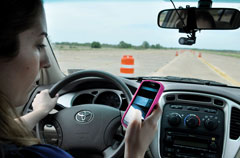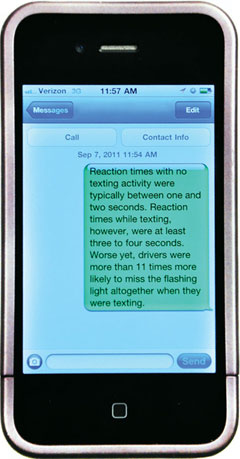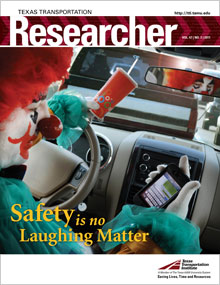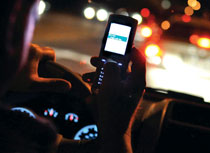Researchers and safety advocates have known for years that driving performance worsens when the driver is texting. Now we know just how much worse.

Federal statistics suggest that distracted driving contributes to as much as 20 percent of all fatal crashes, and that cell phones constitute the primary source of driver distraction. Researchers point to two numbers to illustrate the magnitude of the texting-while-driving problem: an estimated 5 billion text messages are sent each day in the United States, and at least 20 percent of all drivers have admitted to texting while driving.
The study consisted of three major steps. First, participants typed a story of their choice (usually a simple fairy tale) and also read and answered questions related to another story, both on their smart phone in a laboratory setting.
Each participant then navigated a test-track course involving both an open section and a section lined with construction barrels. Drivers first drove the course without texting and then repeated both lab tasks separately while driving through the course again. Throughout the test-track exercise, each participant’s reaction time to a periodic flashing light was recorded.
Reaction times with no texting activity were typically between one and two seconds. Reaction times while texting, however, were at least three to four seconds. Worse yet, drivers were more than 11 times more likely to miss the flashing light altogether when they were texting.
Texas Transportation Institute (TTI) Assistant Research Scientist Joel Cooper directed the study along with TTI colleagues Christine Yager, associate transportation researcher, and Sue Chrysler, manager of TTI’s Human Factors Program. The research involved 42 participants between the ages of 16 and 54 and was funded by the Southwest Region University Transportation Center.
In addition to the reaction-time element, researchers also measured each driver’s ability to maintain proper lane position and a constant speed. Major findings further documented the impairment of texting when compared to the controlled driving conditions. Drivers were less able to:
- safely maintain their position in the driving lane when they were texting, and their swerving was worse in the open sections of the course than in the barreled sections.
- maintain a constant speed while texting, tending to slow down in an effort to reduce the demand of the multiple tasks. By slowing down, a driver gains more time to correct for driving errors (such as the tendency to swerve while texting). Speed variance was also greater for texting drivers than for non-texting drivers.

This work will produce one of the first and only studies in the nation conducted in an actual driving environment. That distinction is important, researchers say, because while simulators are useful, the dynamics of an actual vehicle are different, and some driver cues can’t be replicated in a simulator. By using a closed course, researchers can create an environment similar to real-world driving conditions while providing a high degree of safety for the participants.
“Most research on texting and driving has been limited to driving simulators. This study involved participants driving an actual vehicle,” Yager says. “So one of the more important things we know now that we didn’t know before is that response times are even slower than we previously thought.”
The researchers also examined the productivity level of each driver, measuring the amount of texting activity they could perform while driving. Drivers were generally able to complete about half the exercise content behind the wheel compared to what they could do in the lab setting.
“There’s a general assumption by some people who believe they’re being more productive if they’re exchanging messages while they drive because they’re performing two tasks at once,” Cooper says. “But our findings suggest that the productivity level for each of those tasks drops to less than half what it should be. That indicates to us that texting while driving is not only unsafe, it’s also inefficient.”
The researchers say that another finding from the study dispels a common misconception that composing a text message is a more demanding task than reading one. In post-study interviews, a majority of study participants held that belief, but study results found significant impairment from both reading and writing.
“The findings of this study extend to other distracting activities involving reading and writing, such as checking email or Facebook, while driving,” notes Chrysler.
The total distance covered by each driver in the study was slightly less than 11 miles. In the interest of safety for both participants and the research staff, researchers minimized the complexity of the driving task, using a straight-line course that contained no hills, traffic or potential conflicts other than the construction-zone barrels. Consequently, the driving demands that participants encountered were considerably lower than those they would encounter under real-world conditions.
“It is frightening,” the researchers wrote, “to think of how much more poorly our participants may have performed if the driving conditions were more consistent with routine driving.”

